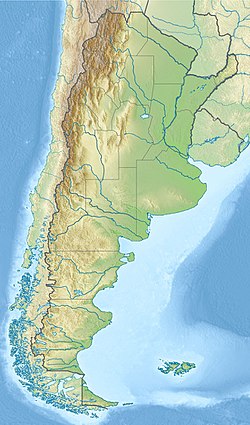Top Qs
Timeline
Chat
Perspective
La Matilde Formation
Jurassic geological formation From Wikipedia, the free encyclopedia
Remove ads
La Matilde Formation is a Jurassic geological formation in the Austral Basin of Santa Cruz Province, Patagonia, Argentina. It is dated to the Middle to Late Jurassic. From the Bathonian age (164.7 to 167.7 million years ago) to the Kimmeridgian age (150.8 to 155.7 million years ago) at the latest.[1][2][3]
The area was once part of the subtropical and temperate regions of the southern supercontinent Gondwana in the Mesozoic era, a more or less continuous landmass consisting of what is now modern South America, Africa, Antarctica, Australia, New Zealand, and New Guinea.[4][5]
Remove ads
Description
La Matilde consists primarily of sedimentary rocks. It includes claystone, coal beds, conglomerates, siltstones, sandstones, and volcanic tuff. La Matilde overlies but sometimes intersperses with the Middle Jurassic Chon Aike Formation.[6] The two formations are the subunits of the Bahía Laura Group.[1]
Fossil content
La Matilde is known for the abundant fossils recovered from it. Notable fossil localities in the formation include the Cerro Cuadrado Petrified Forest, the Cerro Madre e Hija Petrified Forest, and the remains and trace fossils (including trackways) of dinosaurs in the Laguna Manantiales Farm.[7][8]
Fossil taxa recovered from the La Matilde Formation include:[9][10]
- Flora
- Agathoxylon matildense
- Araucaria mirabilis
- Araucarites sanctaecrucis
- Brachyphyllum
- Equisetum thermale[11]
- Pararaucaria patagonica
- Ichnofossils
- Ameghinichnus patagonicus[12]
- Casamiquelichnus navesorum
- Delatorrichnus goyenechei[13]
- Grallator
- Notobatrachus degiustoi
- Sarmientichnus scagliai[13]
- Wildeichnus navesi[14]
Remove ads
See also
References
Further reading
Wikiwand - on
Seamless Wikipedia browsing. On steroids.
Remove ads
